Business Research Methodology Report: Sportswear Brand Loyalty
VerifiedAdded on 2020/04/21
|13
|3894
|343
Report
AI Summary
This report analyzes five case studies focusing on sportswear brand loyalty across different geographical markets, including China, Iran, and the UK. The research explores various factors influencing brand loyalty, such as self-congruity, product quality, price, brand name, and customer satisfaction. The report investigates the impact of these factors on consumer behavior and purchase decisions, examining both attitudinal and behavioral aspects of loyalty. It also delves into research objectives, questions, and the use of narrative literature reviews to support the findings. The cases cover diverse aspects of brand loyalty, from the influence of country of origin to the identification of key brand personality dimensions. The report concludes by evaluating the choice of research, sampling design and the research instruments used.
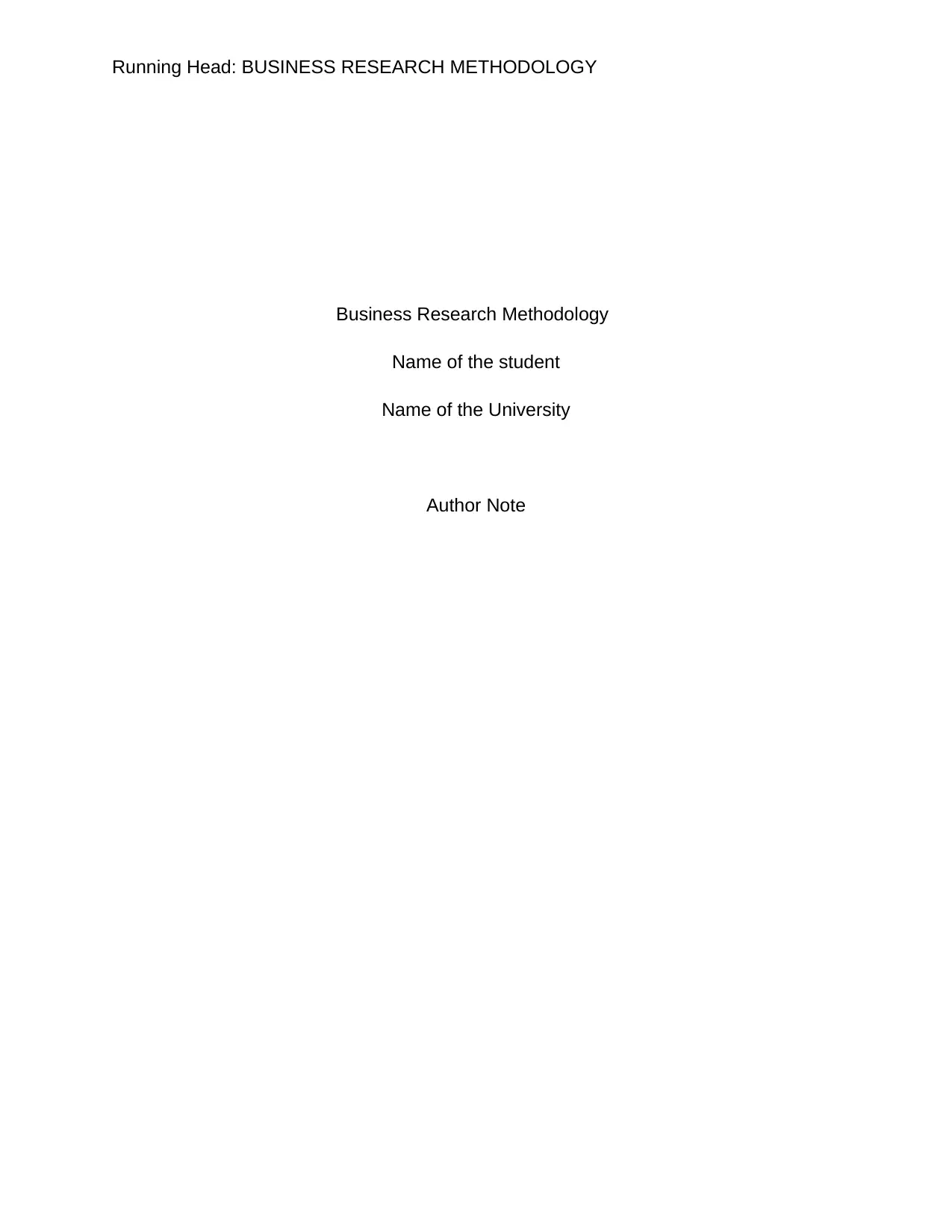
Running Head: BUSINESS RESEARCH METHODOLOGY
Business Research Methodology
Name of the student
Name of the University
Author Note
Business Research Methodology
Name of the student
Name of the University
Author Note
Paraphrase This Document
Need a fresh take? Get an instant paraphrase of this document with our AI Paraphraser
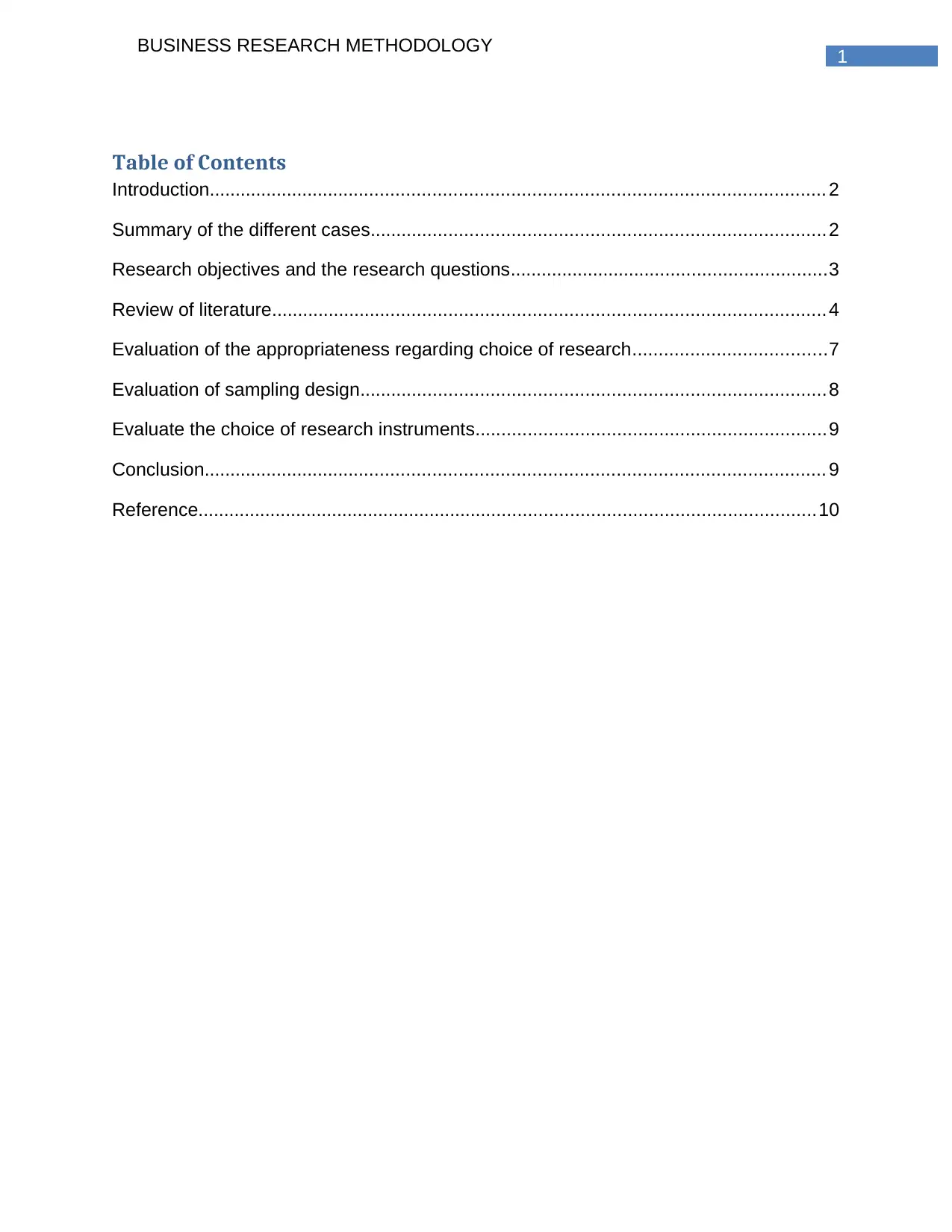
1
BUSINESS RESEARCH METHODOLOGY
Table of Contents
Introduction...................................................................................................................... 2
Summary of the different cases....................................................................................... 2
Research objectives and the research questions.............................................................3
Review of literature.......................................................................................................... 4
Evaluation of the appropriateness regarding choice of research.....................................7
Evaluation of sampling design.........................................................................................8
Evaluate the choice of research instruments...................................................................9
Conclusion....................................................................................................................... 9
Reference.......................................................................................................................10
BUSINESS RESEARCH METHODOLOGY
Table of Contents
Introduction...................................................................................................................... 2
Summary of the different cases....................................................................................... 2
Research objectives and the research questions.............................................................3
Review of literature.......................................................................................................... 4
Evaluation of the appropriateness regarding choice of research.....................................7
Evaluation of sampling design.........................................................................................8
Evaluate the choice of research instruments...................................................................9
Conclusion....................................................................................................................... 9
Reference.......................................................................................................................10
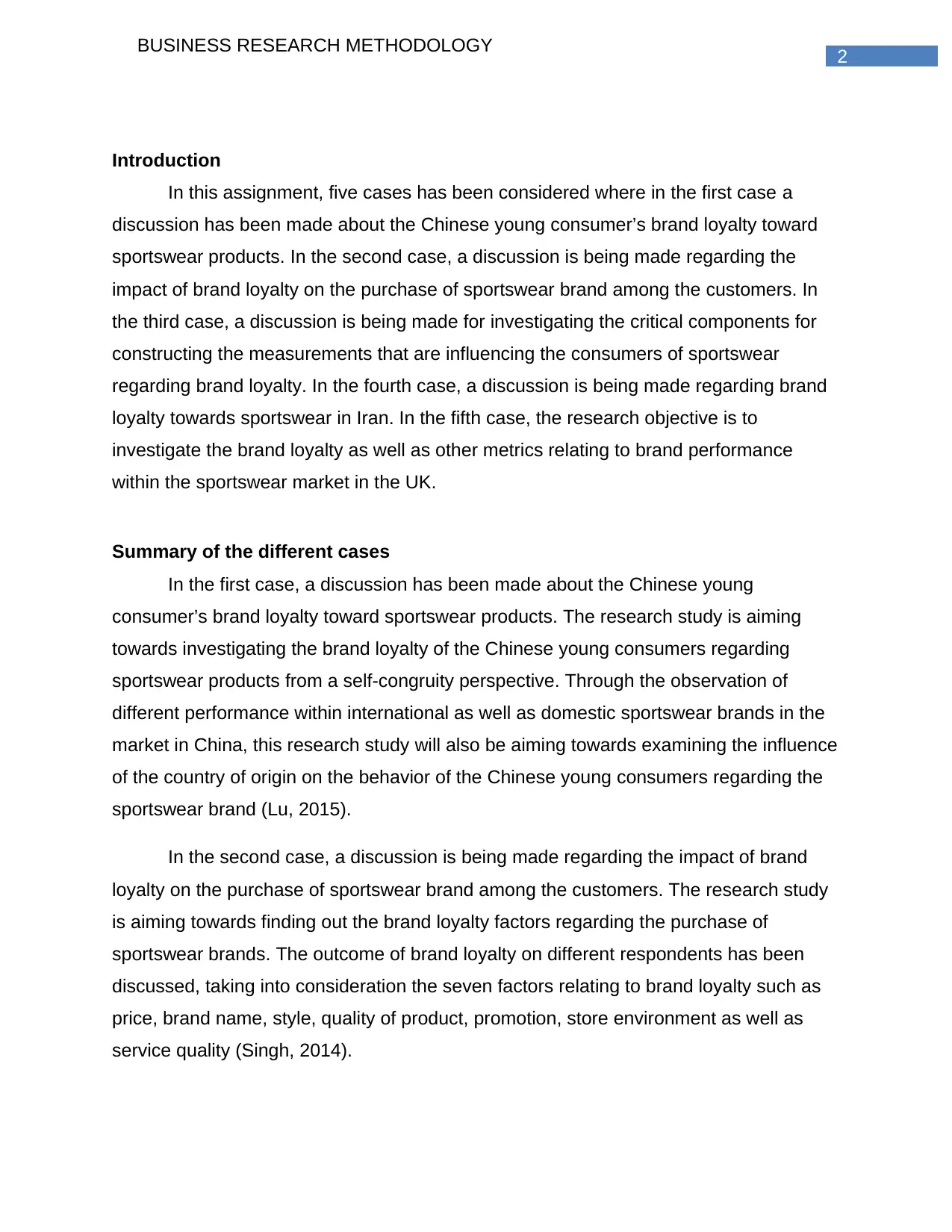
2
BUSINESS RESEARCH METHODOLOGY
Introduction
In this assignment, five cases has been considered where in the first case a
discussion has been made about the Chinese young consumer’s brand loyalty toward
sportswear products. In the second case, a discussion is being made regarding the
impact of brand loyalty on the purchase of sportswear brand among the customers. In
the third case, a discussion is being made for investigating the critical components for
constructing the measurements that are influencing the consumers of sportswear
regarding brand loyalty. In the fourth case, a discussion is being made regarding brand
loyalty towards sportswear in Iran. In the fifth case, the research objective is to
investigate the brand loyalty as well as other metrics relating to brand performance
within the sportswear market in the UK.
Summary of the different cases
In the first case, a discussion has been made about the Chinese young
consumer’s brand loyalty toward sportswear products. The research study is aiming
towards investigating the brand loyalty of the Chinese young consumers regarding
sportswear products from a self-congruity perspective. Through the observation of
different performance within international as well as domestic sportswear brands in the
market in China, this research study will also be aiming towards examining the influence
of the country of origin on the behavior of the Chinese young consumers regarding the
sportswear brand (Lu, 2015).
In the second case, a discussion is being made regarding the impact of brand
loyalty on the purchase of sportswear brand among the customers. The research study
is aiming towards finding out the brand loyalty factors regarding the purchase of
sportswear brands. The outcome of brand loyalty on different respondents has been
discussed, taking into consideration the seven factors relating to brand loyalty such as
price, brand name, style, quality of product, promotion, store environment as well as
service quality (Singh, 2014).
BUSINESS RESEARCH METHODOLOGY
Introduction
In this assignment, five cases has been considered where in the first case a
discussion has been made about the Chinese young consumer’s brand loyalty toward
sportswear products. In the second case, a discussion is being made regarding the
impact of brand loyalty on the purchase of sportswear brand among the customers. In
the third case, a discussion is being made for investigating the critical components for
constructing the measurements that are influencing the consumers of sportswear
regarding brand loyalty. In the fourth case, a discussion is being made regarding brand
loyalty towards sportswear in Iran. In the fifth case, the research objective is to
investigate the brand loyalty as well as other metrics relating to brand performance
within the sportswear market in the UK.
Summary of the different cases
In the first case, a discussion has been made about the Chinese young
consumer’s brand loyalty toward sportswear products. The research study is aiming
towards investigating the brand loyalty of the Chinese young consumers regarding
sportswear products from a self-congruity perspective. Through the observation of
different performance within international as well as domestic sportswear brands in the
market in China, this research study will also be aiming towards examining the influence
of the country of origin on the behavior of the Chinese young consumers regarding the
sportswear brand (Lu, 2015).
In the second case, a discussion is being made regarding the impact of brand
loyalty on the purchase of sportswear brand among the customers. The research study
is aiming towards finding out the brand loyalty factors regarding the purchase of
sportswear brands. The outcome of brand loyalty on different respondents has been
discussed, taking into consideration the seven factors relating to brand loyalty such as
price, brand name, style, quality of product, promotion, store environment as well as
service quality (Singh, 2014).
⊘ This is a preview!⊘
Do you want full access?
Subscribe today to unlock all pages.

Trusted by 1+ million students worldwide
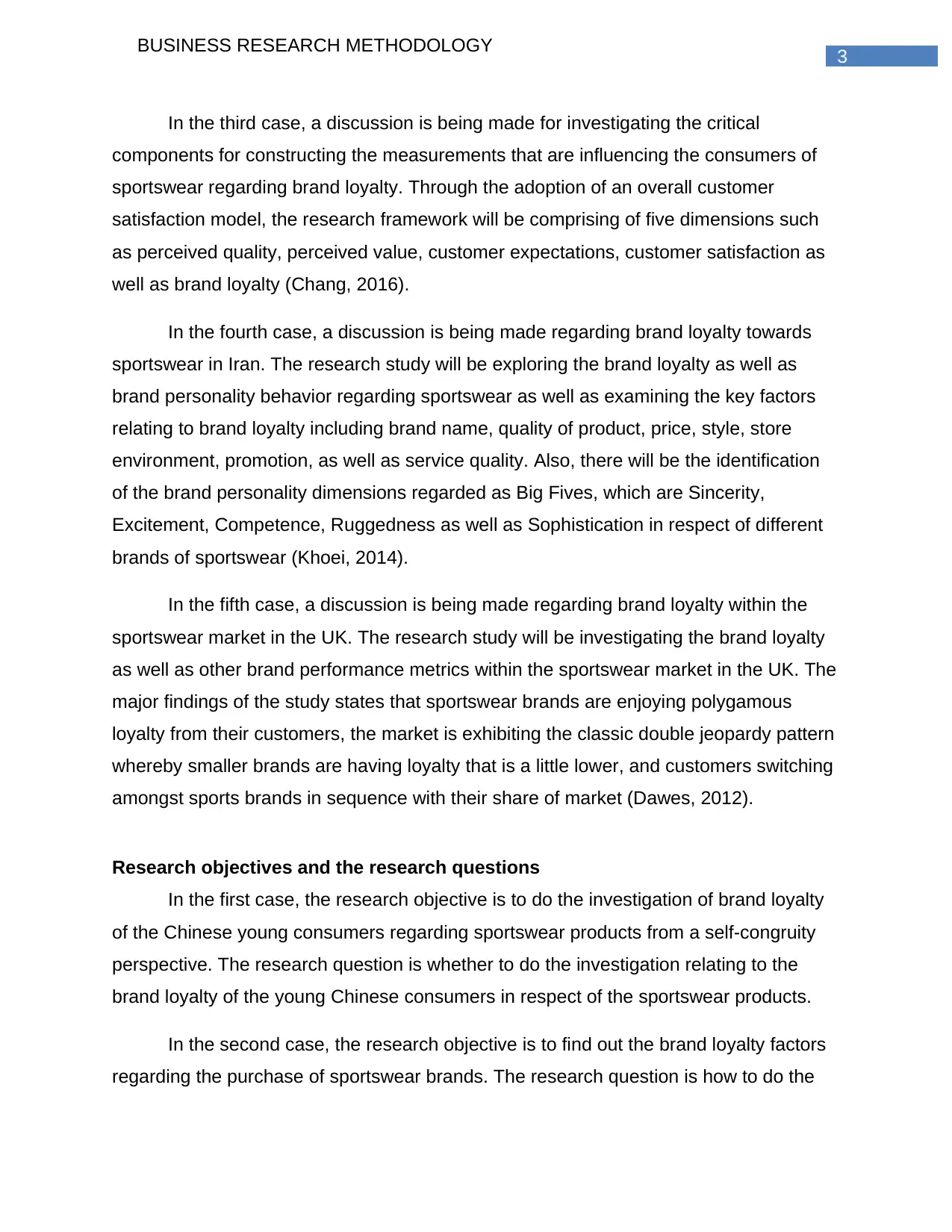
3
BUSINESS RESEARCH METHODOLOGY
In the third case, a discussion is being made for investigating the critical
components for constructing the measurements that are influencing the consumers of
sportswear regarding brand loyalty. Through the adoption of an overall customer
satisfaction model, the research framework will be comprising of five dimensions such
as perceived quality, perceived value, customer expectations, customer satisfaction as
well as brand loyalty (Chang, 2016).
In the fourth case, a discussion is being made regarding brand loyalty towards
sportswear in Iran. The research study will be exploring the brand loyalty as well as
brand personality behavior regarding sportswear as well as examining the key factors
relating to brand loyalty including brand name, quality of product, price, style, store
environment, promotion, as well as service quality. Also, there will be the identification
of the brand personality dimensions regarded as Big Fives, which are Sincerity,
Excitement, Competence, Ruggedness as well as Sophistication in respect of different
brands of sportswear (Khoei, 2014).
In the fifth case, a discussion is being made regarding brand loyalty within the
sportswear market in the UK. The research study will be investigating the brand loyalty
as well as other brand performance metrics within the sportswear market in the UK. The
major findings of the study states that sportswear brands are enjoying polygamous
loyalty from their customers, the market is exhibiting the classic double jeopardy pattern
whereby smaller brands are having loyalty that is a little lower, and customers switching
amongst sports brands in sequence with their share of market (Dawes, 2012).
Research objectives and the research questions
In the first case, the research objective is to do the investigation of brand loyalty
of the Chinese young consumers regarding sportswear products from a self-congruity
perspective. The research question is whether to do the investigation relating to the
brand loyalty of the young Chinese consumers in respect of the sportswear products.
In the second case, the research objective is to find out the brand loyalty factors
regarding the purchase of sportswear brands. The research question is how to do the
BUSINESS RESEARCH METHODOLOGY
In the third case, a discussion is being made for investigating the critical
components for constructing the measurements that are influencing the consumers of
sportswear regarding brand loyalty. Through the adoption of an overall customer
satisfaction model, the research framework will be comprising of five dimensions such
as perceived quality, perceived value, customer expectations, customer satisfaction as
well as brand loyalty (Chang, 2016).
In the fourth case, a discussion is being made regarding brand loyalty towards
sportswear in Iran. The research study will be exploring the brand loyalty as well as
brand personality behavior regarding sportswear as well as examining the key factors
relating to brand loyalty including brand name, quality of product, price, style, store
environment, promotion, as well as service quality. Also, there will be the identification
of the brand personality dimensions regarded as Big Fives, which are Sincerity,
Excitement, Competence, Ruggedness as well as Sophistication in respect of different
brands of sportswear (Khoei, 2014).
In the fifth case, a discussion is being made regarding brand loyalty within the
sportswear market in the UK. The research study will be investigating the brand loyalty
as well as other brand performance metrics within the sportswear market in the UK. The
major findings of the study states that sportswear brands are enjoying polygamous
loyalty from their customers, the market is exhibiting the classic double jeopardy pattern
whereby smaller brands are having loyalty that is a little lower, and customers switching
amongst sports brands in sequence with their share of market (Dawes, 2012).
Research objectives and the research questions
In the first case, the research objective is to do the investigation of brand loyalty
of the Chinese young consumers regarding sportswear products from a self-congruity
perspective. The research question is whether to do the investigation relating to the
brand loyalty of the young Chinese consumers in respect of the sportswear products.
In the second case, the research objective is to find out the brand loyalty factors
regarding the purchase of sportswear brands. The research question is how to do the
Paraphrase This Document
Need a fresh take? Get an instant paraphrase of this document with our AI Paraphraser
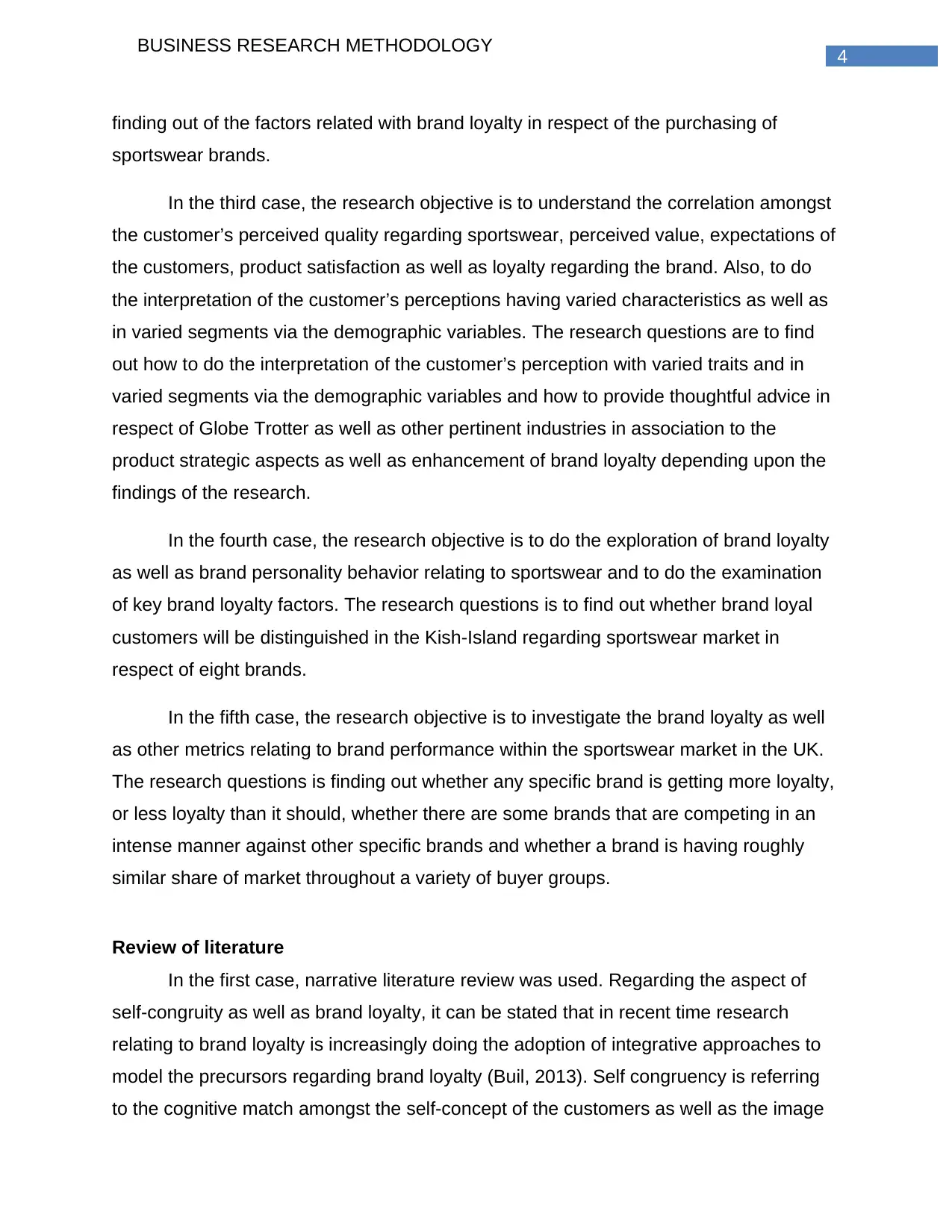
4
BUSINESS RESEARCH METHODOLOGY
finding out of the factors related with brand loyalty in respect of the purchasing of
sportswear brands.
In the third case, the research objective is to understand the correlation amongst
the customer’s perceived quality regarding sportswear, perceived value, expectations of
the customers, product satisfaction as well as loyalty regarding the brand. Also, to do
the interpretation of the customer’s perceptions having varied characteristics as well as
in varied segments via the demographic variables. The research questions are to find
out how to do the interpretation of the customer’s perception with varied traits and in
varied segments via the demographic variables and how to provide thoughtful advice in
respect of Globe Trotter as well as other pertinent industries in association to the
product strategic aspects as well as enhancement of brand loyalty depending upon the
findings of the research.
In the fourth case, the research objective is to do the exploration of brand loyalty
as well as brand personality behavior relating to sportswear and to do the examination
of key brand loyalty factors. The research questions is to find out whether brand loyal
customers will be distinguished in the Kish-Island regarding sportswear market in
respect of eight brands.
In the fifth case, the research objective is to investigate the brand loyalty as well
as other metrics relating to brand performance within the sportswear market in the UK.
The research questions is finding out whether any specific brand is getting more loyalty,
or less loyalty than it should, whether there are some brands that are competing in an
intense manner against other specific brands and whether a brand is having roughly
similar share of market throughout a variety of buyer groups.
Review of literature
In the first case, narrative literature review was used. Regarding the aspect of
self-congruity as well as brand loyalty, it can be stated that in recent time research
relating to brand loyalty is increasingly doing the adoption of integrative approaches to
model the precursors regarding brand loyalty (Buil, 2013). Self congruency is referring
to the cognitive match amongst the self-concept of the customers as well as the image
BUSINESS RESEARCH METHODOLOGY
finding out of the factors related with brand loyalty in respect of the purchasing of
sportswear brands.
In the third case, the research objective is to understand the correlation amongst
the customer’s perceived quality regarding sportswear, perceived value, expectations of
the customers, product satisfaction as well as loyalty regarding the brand. Also, to do
the interpretation of the customer’s perceptions having varied characteristics as well as
in varied segments via the demographic variables. The research questions are to find
out how to do the interpretation of the customer’s perception with varied traits and in
varied segments via the demographic variables and how to provide thoughtful advice in
respect of Globe Trotter as well as other pertinent industries in association to the
product strategic aspects as well as enhancement of brand loyalty depending upon the
findings of the research.
In the fourth case, the research objective is to do the exploration of brand loyalty
as well as brand personality behavior relating to sportswear and to do the examination
of key brand loyalty factors. The research questions is to find out whether brand loyal
customers will be distinguished in the Kish-Island regarding sportswear market in
respect of eight brands.
In the fifth case, the research objective is to investigate the brand loyalty as well
as other metrics relating to brand performance within the sportswear market in the UK.
The research questions is finding out whether any specific brand is getting more loyalty,
or less loyalty than it should, whether there are some brands that are competing in an
intense manner against other specific brands and whether a brand is having roughly
similar share of market throughout a variety of buyer groups.
Review of literature
In the first case, narrative literature review was used. Regarding the aspect of
self-congruity as well as brand loyalty, it can be stated that in recent time research
relating to brand loyalty is increasingly doing the adoption of integrative approaches to
model the precursors regarding brand loyalty (Buil, 2013). Self congruency is referring
to the cognitive match amongst the self-concept of the customers as well as the image
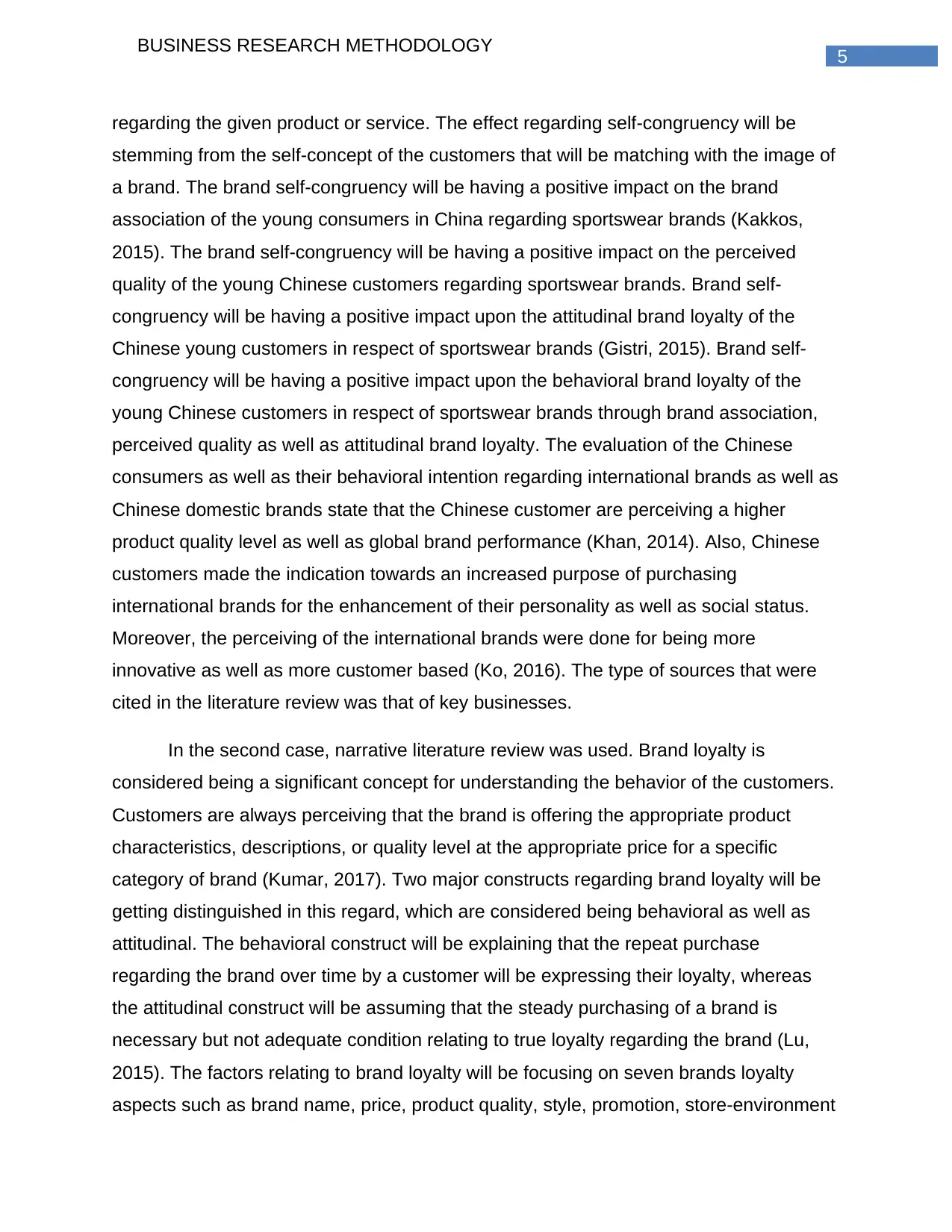
5
BUSINESS RESEARCH METHODOLOGY
regarding the given product or service. The effect regarding self-congruency will be
stemming from the self-concept of the customers that will be matching with the image of
a brand. The brand self-congruency will be having a positive impact on the brand
association of the young consumers in China regarding sportswear brands (Kakkos,
2015). The brand self-congruency will be having a positive impact on the perceived
quality of the young Chinese customers regarding sportswear brands. Brand self-
congruency will be having a positive impact upon the attitudinal brand loyalty of the
Chinese young customers in respect of sportswear brands (Gistri, 2015). Brand self-
congruency will be having a positive impact upon the behavioral brand loyalty of the
young Chinese customers in respect of sportswear brands through brand association,
perceived quality as well as attitudinal brand loyalty. The evaluation of the Chinese
consumers as well as their behavioral intention regarding international brands as well as
Chinese domestic brands state that the Chinese customer are perceiving a higher
product quality level as well as global brand performance (Khan, 2014). Also, Chinese
customers made the indication towards an increased purpose of purchasing
international brands for the enhancement of their personality as well as social status.
Moreover, the perceiving of the international brands were done for being more
innovative as well as more customer based (Ko, 2016). The type of sources that were
cited in the literature review was that of key businesses.
In the second case, narrative literature review was used. Brand loyalty is
considered being a significant concept for understanding the behavior of the customers.
Customers are always perceiving that the brand is offering the appropriate product
characteristics, descriptions, or quality level at the appropriate price for a specific
category of brand (Kumar, 2017). Two major constructs regarding brand loyalty will be
getting distinguished in this regard, which are considered being behavioral as well as
attitudinal. The behavioral construct will be explaining that the repeat purchase
regarding the brand over time by a customer will be expressing their loyalty, whereas
the attitudinal construct will be assuming that the steady purchasing of a brand is
necessary but not adequate condition relating to true loyalty regarding the brand (Lu,
2015). The factors relating to brand loyalty will be focusing on seven brands loyalty
aspects such as brand name, price, product quality, style, promotion, store-environment
BUSINESS RESEARCH METHODOLOGY
regarding the given product or service. The effect regarding self-congruency will be
stemming from the self-concept of the customers that will be matching with the image of
a brand. The brand self-congruency will be having a positive impact on the brand
association of the young consumers in China regarding sportswear brands (Kakkos,
2015). The brand self-congruency will be having a positive impact on the perceived
quality of the young Chinese customers regarding sportswear brands. Brand self-
congruency will be having a positive impact upon the attitudinal brand loyalty of the
Chinese young customers in respect of sportswear brands (Gistri, 2015). Brand self-
congruency will be having a positive impact upon the behavioral brand loyalty of the
young Chinese customers in respect of sportswear brands through brand association,
perceived quality as well as attitudinal brand loyalty. The evaluation of the Chinese
consumers as well as their behavioral intention regarding international brands as well as
Chinese domestic brands state that the Chinese customer are perceiving a higher
product quality level as well as global brand performance (Khan, 2014). Also, Chinese
customers made the indication towards an increased purpose of purchasing
international brands for the enhancement of their personality as well as social status.
Moreover, the perceiving of the international brands were done for being more
innovative as well as more customer based (Ko, 2016). The type of sources that were
cited in the literature review was that of key businesses.
In the second case, narrative literature review was used. Brand loyalty is
considered being a significant concept for understanding the behavior of the customers.
Customers are always perceiving that the brand is offering the appropriate product
characteristics, descriptions, or quality level at the appropriate price for a specific
category of brand (Kumar, 2017). Two major constructs regarding brand loyalty will be
getting distinguished in this regard, which are considered being behavioral as well as
attitudinal. The behavioral construct will be explaining that the repeat purchase
regarding the brand over time by a customer will be expressing their loyalty, whereas
the attitudinal construct will be assuming that the steady purchasing of a brand is
necessary but not adequate condition relating to true loyalty regarding the brand (Lu,
2015). The factors relating to brand loyalty will be focusing on seven brands loyalty
aspects such as brand name, price, product quality, style, promotion, store-environment
⊘ This is a preview!⊘
Do you want full access?
Subscribe today to unlock all pages.

Trusted by 1+ million students worldwide
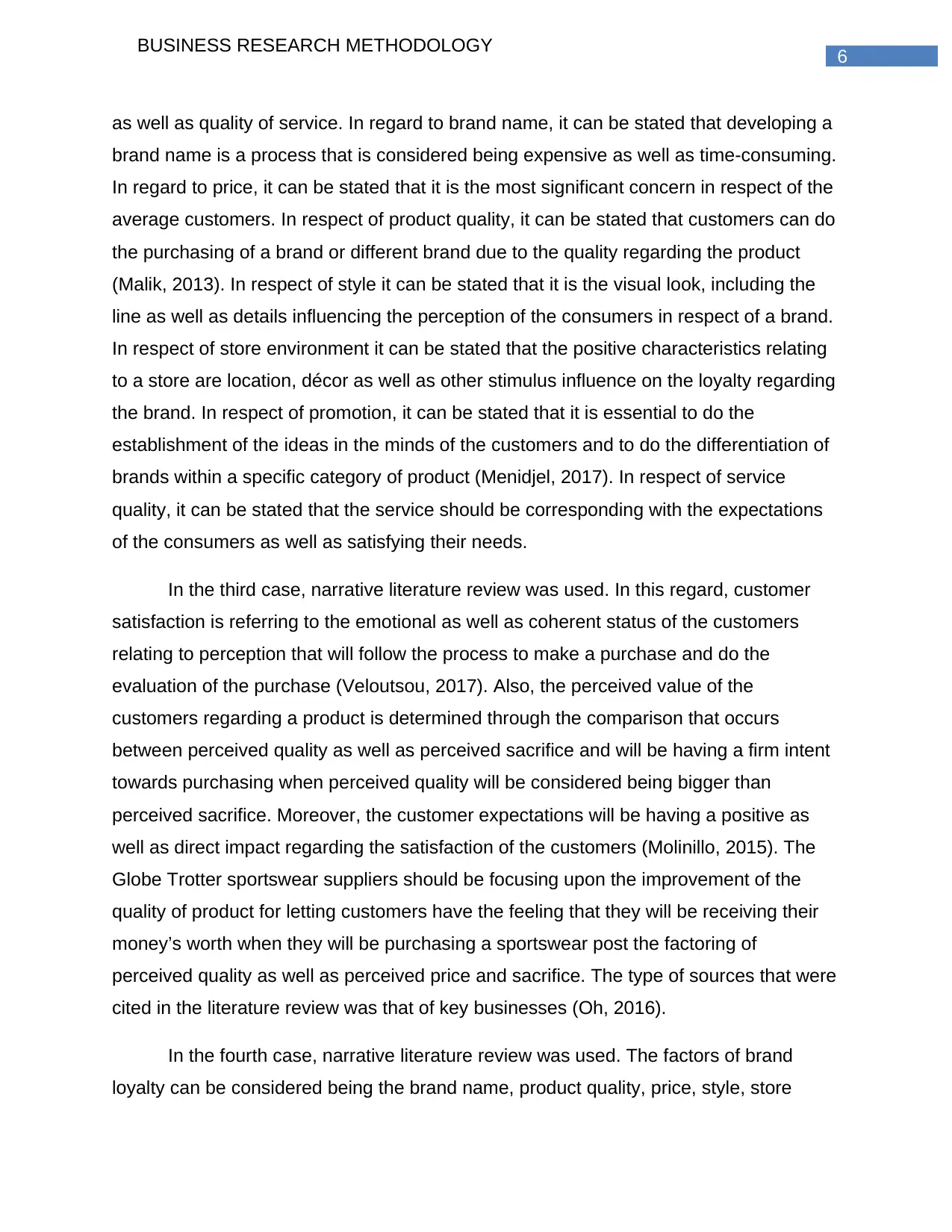
6
BUSINESS RESEARCH METHODOLOGY
as well as quality of service. In regard to brand name, it can be stated that developing a
brand name is a process that is considered being expensive as well as time-consuming.
In regard to price, it can be stated that it is the most significant concern in respect of the
average customers. In respect of product quality, it can be stated that customers can do
the purchasing of a brand or different brand due to the quality regarding the product
(Malik, 2013). In respect of style it can be stated that it is the visual look, including the
line as well as details influencing the perception of the consumers in respect of a brand.
In respect of store environment it can be stated that the positive characteristics relating
to a store are location, décor as well as other stimulus influence on the loyalty regarding
the brand. In respect of promotion, it can be stated that it is essential to do the
establishment of the ideas in the minds of the customers and to do the differentiation of
brands within a specific category of product (Menidjel, 2017). In respect of service
quality, it can be stated that the service should be corresponding with the expectations
of the consumers as well as satisfying their needs.
In the third case, narrative literature review was used. In this regard, customer
satisfaction is referring to the emotional as well as coherent status of the customers
relating to perception that will follow the process to make a purchase and do the
evaluation of the purchase (Veloutsou, 2017). Also, the perceived value of the
customers regarding a product is determined through the comparison that occurs
between perceived quality as well as perceived sacrifice and will be having a firm intent
towards purchasing when perceived quality will be considered being bigger than
perceived sacrifice. Moreover, the customer expectations will be having a positive as
well as direct impact regarding the satisfaction of the customers (Molinillo, 2015). The
Globe Trotter sportswear suppliers should be focusing upon the improvement of the
quality of product for letting customers have the feeling that they will be receiving their
money’s worth when they will be purchasing a sportswear post the factoring of
perceived quality as well as perceived price and sacrifice. The type of sources that were
cited in the literature review was that of key businesses (Oh, 2016).
In the fourth case, narrative literature review was used. The factors of brand
loyalty can be considered being the brand name, product quality, price, style, store
BUSINESS RESEARCH METHODOLOGY
as well as quality of service. In regard to brand name, it can be stated that developing a
brand name is a process that is considered being expensive as well as time-consuming.
In regard to price, it can be stated that it is the most significant concern in respect of the
average customers. In respect of product quality, it can be stated that customers can do
the purchasing of a brand or different brand due to the quality regarding the product
(Malik, 2013). In respect of style it can be stated that it is the visual look, including the
line as well as details influencing the perception of the consumers in respect of a brand.
In respect of store environment it can be stated that the positive characteristics relating
to a store are location, décor as well as other stimulus influence on the loyalty regarding
the brand. In respect of promotion, it can be stated that it is essential to do the
establishment of the ideas in the minds of the customers and to do the differentiation of
brands within a specific category of product (Menidjel, 2017). In respect of service
quality, it can be stated that the service should be corresponding with the expectations
of the consumers as well as satisfying their needs.
In the third case, narrative literature review was used. In this regard, customer
satisfaction is referring to the emotional as well as coherent status of the customers
relating to perception that will follow the process to make a purchase and do the
evaluation of the purchase (Veloutsou, 2017). Also, the perceived value of the
customers regarding a product is determined through the comparison that occurs
between perceived quality as well as perceived sacrifice and will be having a firm intent
towards purchasing when perceived quality will be considered being bigger than
perceived sacrifice. Moreover, the customer expectations will be having a positive as
well as direct impact regarding the satisfaction of the customers (Molinillo, 2015). The
Globe Trotter sportswear suppliers should be focusing upon the improvement of the
quality of product for letting customers have the feeling that they will be receiving their
money’s worth when they will be purchasing a sportswear post the factoring of
perceived quality as well as perceived price and sacrifice. The type of sources that were
cited in the literature review was that of key businesses (Oh, 2016).
In the fourth case, narrative literature review was used. The factors of brand
loyalty can be considered being the brand name, product quality, price, style, store
Paraphrase This Document
Need a fresh take? Get an instant paraphrase of this document with our AI Paraphraser
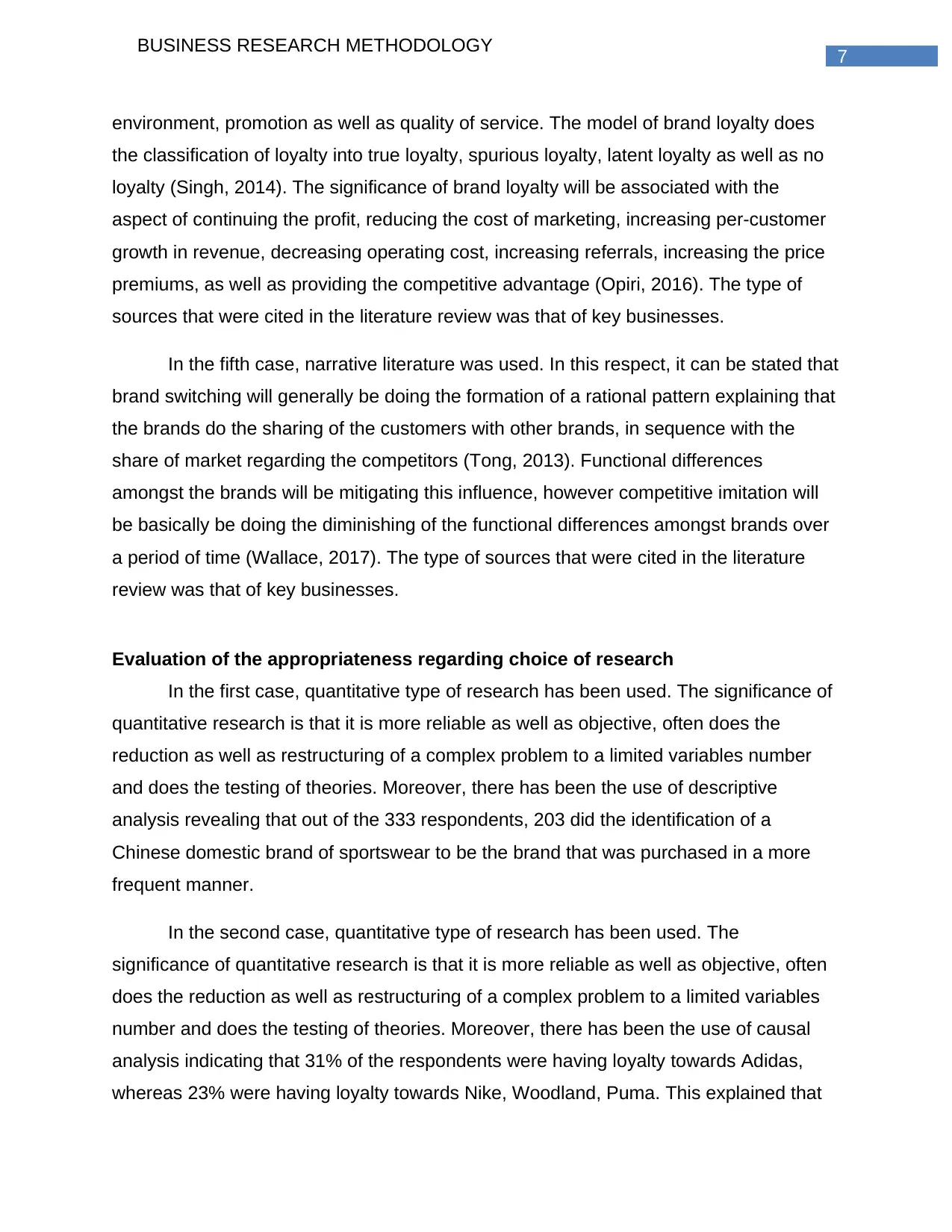
7
BUSINESS RESEARCH METHODOLOGY
environment, promotion as well as quality of service. The model of brand loyalty does
the classification of loyalty into true loyalty, spurious loyalty, latent loyalty as well as no
loyalty (Singh, 2014). The significance of brand loyalty will be associated with the
aspect of continuing the profit, reducing the cost of marketing, increasing per-customer
growth in revenue, decreasing operating cost, increasing referrals, increasing the price
premiums, as well as providing the competitive advantage (Opiri, 2016). The type of
sources that were cited in the literature review was that of key businesses.
In the fifth case, narrative literature was used. In this respect, it can be stated that
brand switching will generally be doing the formation of a rational pattern explaining that
the brands do the sharing of the customers with other brands, in sequence with the
share of market regarding the competitors (Tong, 2013). Functional differences
amongst the brands will be mitigating this influence, however competitive imitation will
be basically be doing the diminishing of the functional differences amongst brands over
a period of time (Wallace, 2017). The type of sources that were cited in the literature
review was that of key businesses.
Evaluation of the appropriateness regarding choice of research
In the first case, quantitative type of research has been used. The significance of
quantitative research is that it is more reliable as well as objective, often does the
reduction as well as restructuring of a complex problem to a limited variables number
and does the testing of theories. Moreover, there has been the use of descriptive
analysis revealing that out of the 333 respondents, 203 did the identification of a
Chinese domestic brand of sportswear to be the brand that was purchased in a more
frequent manner.
In the second case, quantitative type of research has been used. The
significance of quantitative research is that it is more reliable as well as objective, often
does the reduction as well as restructuring of a complex problem to a limited variables
number and does the testing of theories. Moreover, there has been the use of causal
analysis indicating that 31% of the respondents were having loyalty towards Adidas,
whereas 23% were having loyalty towards Nike, Woodland, Puma. This explained that
BUSINESS RESEARCH METHODOLOGY
environment, promotion as well as quality of service. The model of brand loyalty does
the classification of loyalty into true loyalty, spurious loyalty, latent loyalty as well as no
loyalty (Singh, 2014). The significance of brand loyalty will be associated with the
aspect of continuing the profit, reducing the cost of marketing, increasing per-customer
growth in revenue, decreasing operating cost, increasing referrals, increasing the price
premiums, as well as providing the competitive advantage (Opiri, 2016). The type of
sources that were cited in the literature review was that of key businesses.
In the fifth case, narrative literature was used. In this respect, it can be stated that
brand switching will generally be doing the formation of a rational pattern explaining that
the brands do the sharing of the customers with other brands, in sequence with the
share of market regarding the competitors (Tong, 2013). Functional differences
amongst the brands will be mitigating this influence, however competitive imitation will
be basically be doing the diminishing of the functional differences amongst brands over
a period of time (Wallace, 2017). The type of sources that were cited in the literature
review was that of key businesses.
Evaluation of the appropriateness regarding choice of research
In the first case, quantitative type of research has been used. The significance of
quantitative research is that it is more reliable as well as objective, often does the
reduction as well as restructuring of a complex problem to a limited variables number
and does the testing of theories. Moreover, there has been the use of descriptive
analysis revealing that out of the 333 respondents, 203 did the identification of a
Chinese domestic brand of sportswear to be the brand that was purchased in a more
frequent manner.
In the second case, quantitative type of research has been used. The
significance of quantitative research is that it is more reliable as well as objective, often
does the reduction as well as restructuring of a complex problem to a limited variables
number and does the testing of theories. Moreover, there has been the use of causal
analysis indicating that 31% of the respondents were having loyalty towards Adidas,
whereas 23% were having loyalty towards Nike, Woodland, Puma. This explained that
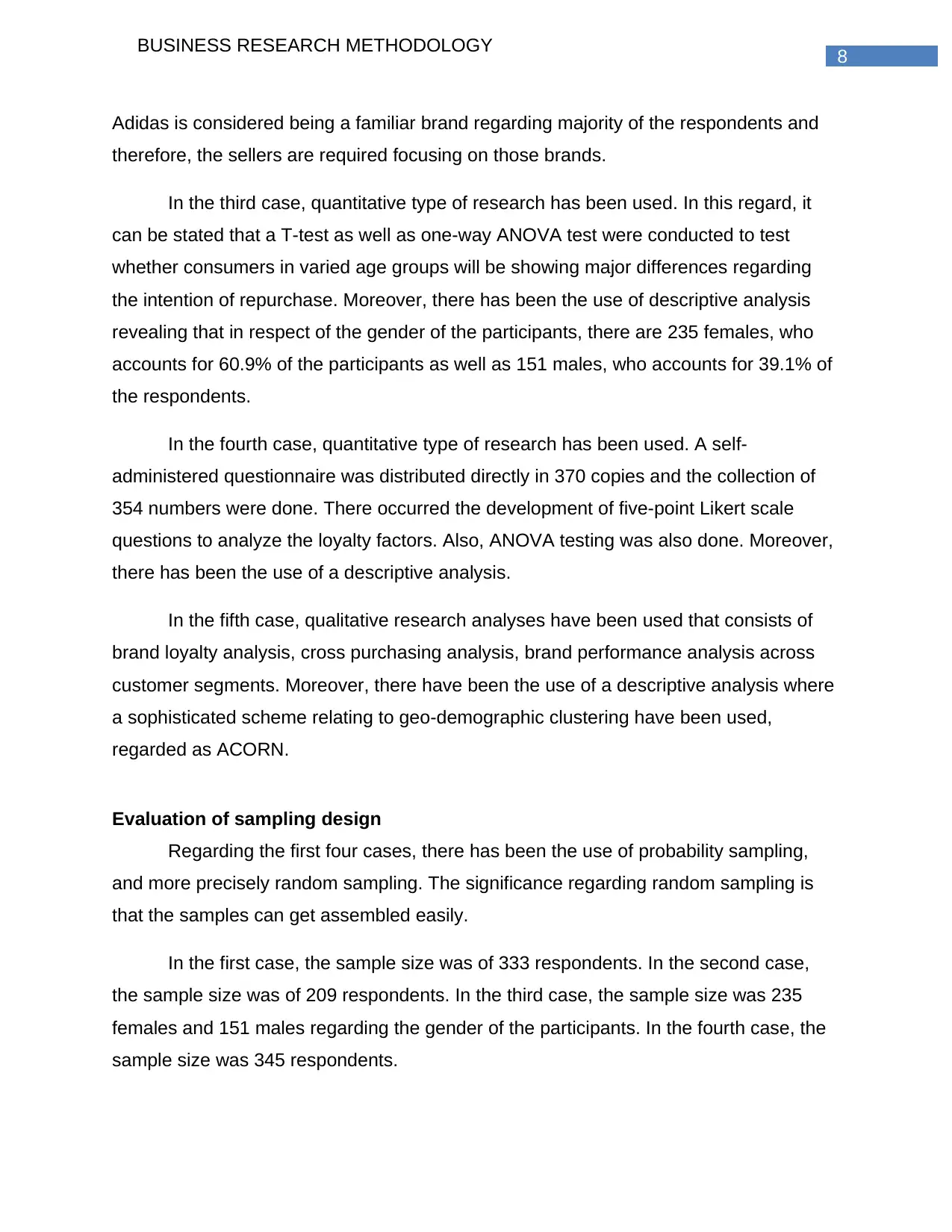
8
BUSINESS RESEARCH METHODOLOGY
Adidas is considered being a familiar brand regarding majority of the respondents and
therefore, the sellers are required focusing on those brands.
In the third case, quantitative type of research has been used. In this regard, it
can be stated that a T-test as well as one-way ANOVA test were conducted to test
whether consumers in varied age groups will be showing major differences regarding
the intention of repurchase. Moreover, there has been the use of descriptive analysis
revealing that in respect of the gender of the participants, there are 235 females, who
accounts for 60.9% of the participants as well as 151 males, who accounts for 39.1% of
the respondents.
In the fourth case, quantitative type of research has been used. A self-
administered questionnaire was distributed directly in 370 copies and the collection of
354 numbers were done. There occurred the development of five-point Likert scale
questions to analyze the loyalty factors. Also, ANOVA testing was also done. Moreover,
there has been the use of a descriptive analysis.
In the fifth case, qualitative research analyses have been used that consists of
brand loyalty analysis, cross purchasing analysis, brand performance analysis across
customer segments. Moreover, there have been the use of a descriptive analysis where
a sophisticated scheme relating to geo-demographic clustering have been used,
regarded as ACORN.
Evaluation of sampling design
Regarding the first four cases, there has been the use of probability sampling,
and more precisely random sampling. The significance regarding random sampling is
that the samples can get assembled easily.
In the first case, the sample size was of 333 respondents. In the second case,
the sample size was of 209 respondents. In the third case, the sample size was 235
females and 151 males regarding the gender of the participants. In the fourth case, the
sample size was 345 respondents.
BUSINESS RESEARCH METHODOLOGY
Adidas is considered being a familiar brand regarding majority of the respondents and
therefore, the sellers are required focusing on those brands.
In the third case, quantitative type of research has been used. In this regard, it
can be stated that a T-test as well as one-way ANOVA test were conducted to test
whether consumers in varied age groups will be showing major differences regarding
the intention of repurchase. Moreover, there has been the use of descriptive analysis
revealing that in respect of the gender of the participants, there are 235 females, who
accounts for 60.9% of the participants as well as 151 males, who accounts for 39.1% of
the respondents.
In the fourth case, quantitative type of research has been used. A self-
administered questionnaire was distributed directly in 370 copies and the collection of
354 numbers were done. There occurred the development of five-point Likert scale
questions to analyze the loyalty factors. Also, ANOVA testing was also done. Moreover,
there has been the use of a descriptive analysis.
In the fifth case, qualitative research analyses have been used that consists of
brand loyalty analysis, cross purchasing analysis, brand performance analysis across
customer segments. Moreover, there have been the use of a descriptive analysis where
a sophisticated scheme relating to geo-demographic clustering have been used,
regarded as ACORN.
Evaluation of sampling design
Regarding the first four cases, there has been the use of probability sampling,
and more precisely random sampling. The significance regarding random sampling is
that the samples can get assembled easily.
In the first case, the sample size was of 333 respondents. In the second case,
the sample size was of 209 respondents. In the third case, the sample size was 235
females and 151 males regarding the gender of the participants. In the fourth case, the
sample size was 345 respondents.
⊘ This is a preview!⊘
Do you want full access?
Subscribe today to unlock all pages.

Trusted by 1+ million students worldwide
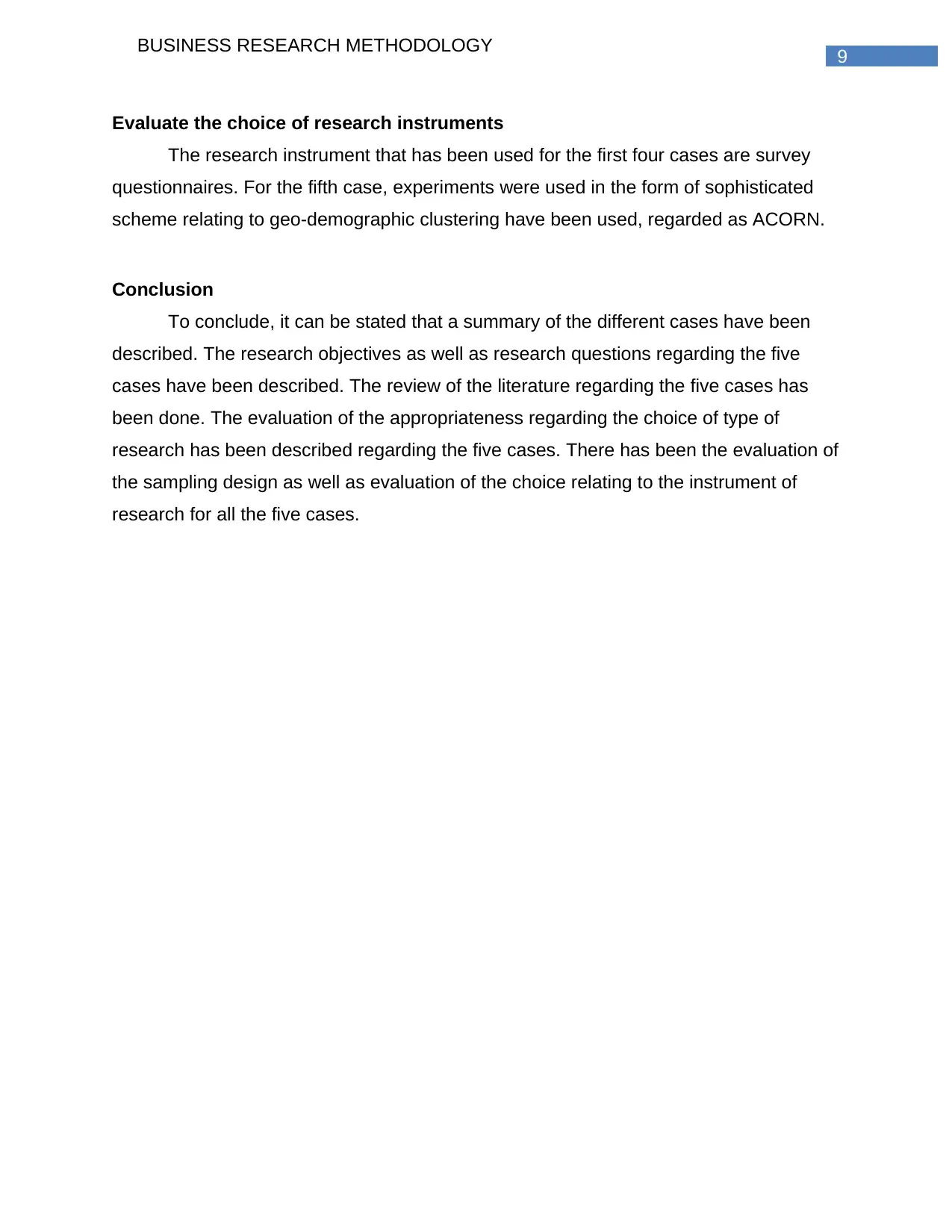
9
BUSINESS RESEARCH METHODOLOGY
Evaluate the choice of research instruments
The research instrument that has been used for the first four cases are survey
questionnaires. For the fifth case, experiments were used in the form of sophisticated
scheme relating to geo-demographic clustering have been used, regarded as ACORN.
Conclusion
To conclude, it can be stated that a summary of the different cases have been
described. The research objectives as well as research questions regarding the five
cases have been described. The review of the literature regarding the five cases has
been done. The evaluation of the appropriateness regarding the choice of type of
research has been described regarding the five cases. There has been the evaluation of
the sampling design as well as evaluation of the choice relating to the instrument of
research for all the five cases.
BUSINESS RESEARCH METHODOLOGY
Evaluate the choice of research instruments
The research instrument that has been used for the first four cases are survey
questionnaires. For the fifth case, experiments were used in the form of sophisticated
scheme relating to geo-demographic clustering have been used, regarded as ACORN.
Conclusion
To conclude, it can be stated that a summary of the different cases have been
described. The research objectives as well as research questions regarding the five
cases have been described. The review of the literature regarding the five cases has
been done. The evaluation of the appropriateness regarding the choice of type of
research has been described regarding the five cases. There has been the evaluation of
the sampling design as well as evaluation of the choice relating to the instrument of
research for all the five cases.
Paraphrase This Document
Need a fresh take? Get an instant paraphrase of this document with our AI Paraphraser
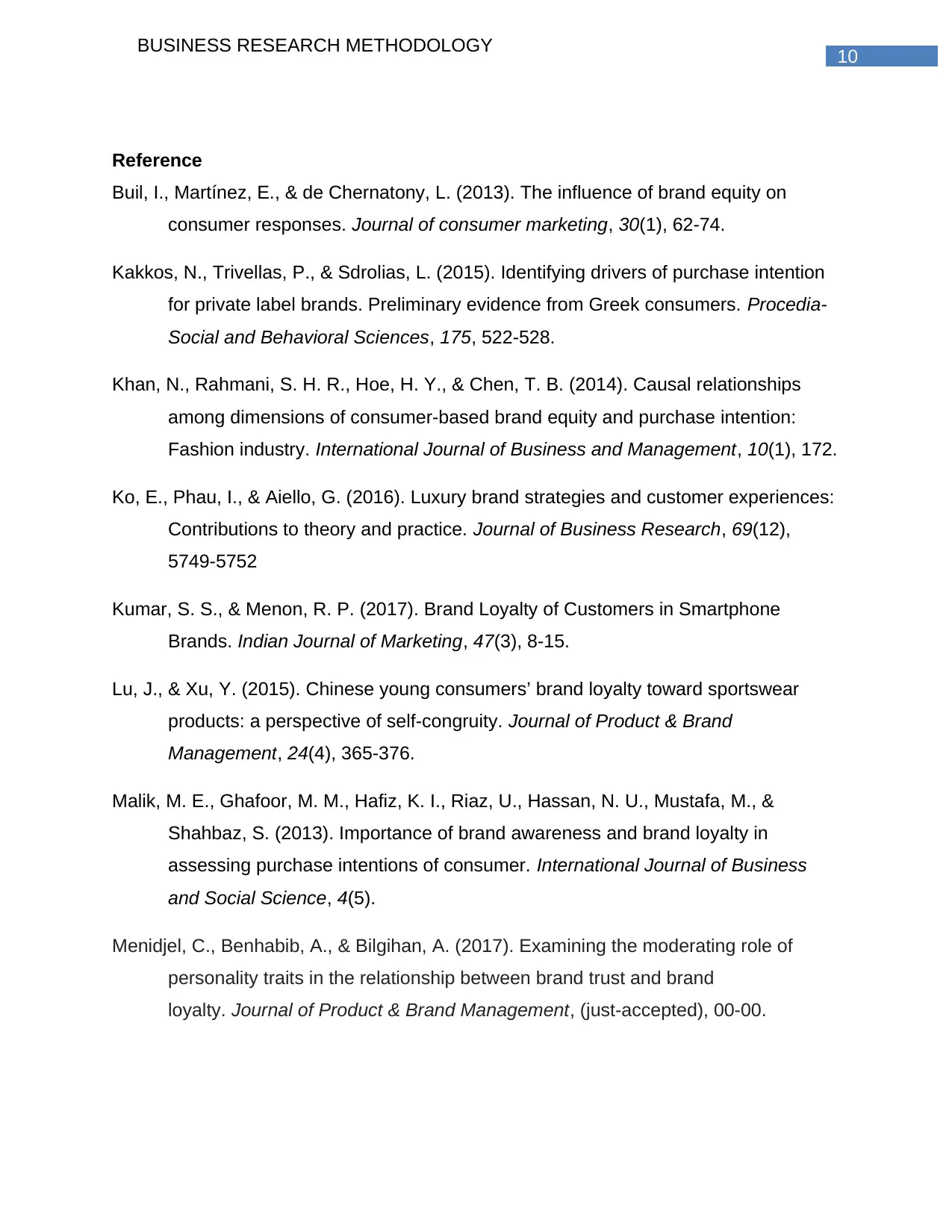
10
BUSINESS RESEARCH METHODOLOGY
Reference
Buil, I., Martínez, E., & de Chernatony, L. (2013). The influence of brand equity on
consumer responses. Journal of consumer marketing, 30(1), 62-74.
Kakkos, N., Trivellas, P., & Sdrolias, L. (2015). Identifying drivers of purchase intention
for private label brands. Preliminary evidence from Greek consumers. Procedia-
Social and Behavioral Sciences, 175, 522-528.
Khan, N., Rahmani, S. H. R., Hoe, H. Y., & Chen, T. B. (2014). Causal relationships
among dimensions of consumer-based brand equity and purchase intention:
Fashion industry. International Journal of Business and Management, 10(1), 172.
Ko, E., Phau, I., & Aiello, G. (2016). Luxury brand strategies and customer experiences:
Contributions to theory and practice. Journal of Business Research, 69(12),
5749-5752
Kumar, S. S., & Menon, R. P. (2017). Brand Loyalty of Customers in Smartphone
Brands. Indian Journal of Marketing, 47(3), 8-15.
Lu, J., & Xu, Y. (2015). Chinese young consumers’ brand loyalty toward sportswear
products: a perspective of self-congruity. Journal of Product & Brand
Management, 24(4), 365-376.
Malik, M. E., Ghafoor, M. M., Hafiz, K. I., Riaz, U., Hassan, N. U., Mustafa, M., &
Shahbaz, S. (2013). Importance of brand awareness and brand loyalty in
assessing purchase intentions of consumer. International Journal of Business
and Social Science, 4(5).
Menidjel, C., Benhabib, A., & Bilgihan, A. (2017). Examining the moderating role of
personality traits in the relationship between brand trust and brand
loyalty. Journal of Product & Brand Management, (just-accepted), 00-00.
BUSINESS RESEARCH METHODOLOGY
Reference
Buil, I., Martínez, E., & de Chernatony, L. (2013). The influence of brand equity on
consumer responses. Journal of consumer marketing, 30(1), 62-74.
Kakkos, N., Trivellas, P., & Sdrolias, L. (2015). Identifying drivers of purchase intention
for private label brands. Preliminary evidence from Greek consumers. Procedia-
Social and Behavioral Sciences, 175, 522-528.
Khan, N., Rahmani, S. H. R., Hoe, H. Y., & Chen, T. B. (2014). Causal relationships
among dimensions of consumer-based brand equity and purchase intention:
Fashion industry. International Journal of Business and Management, 10(1), 172.
Ko, E., Phau, I., & Aiello, G. (2016). Luxury brand strategies and customer experiences:
Contributions to theory and practice. Journal of Business Research, 69(12),
5749-5752
Kumar, S. S., & Menon, R. P. (2017). Brand Loyalty of Customers in Smartphone
Brands. Indian Journal of Marketing, 47(3), 8-15.
Lu, J., & Xu, Y. (2015). Chinese young consumers’ brand loyalty toward sportswear
products: a perspective of self-congruity. Journal of Product & Brand
Management, 24(4), 365-376.
Malik, M. E., Ghafoor, M. M., Hafiz, K. I., Riaz, U., Hassan, N. U., Mustafa, M., &
Shahbaz, S. (2013). Importance of brand awareness and brand loyalty in
assessing purchase intentions of consumer. International Journal of Business
and Social Science, 4(5).
Menidjel, C., Benhabib, A., & Bilgihan, A. (2017). Examining the moderating role of
personality traits in the relationship between brand trust and brand
loyalty. Journal of Product & Brand Management, (just-accepted), 00-00.
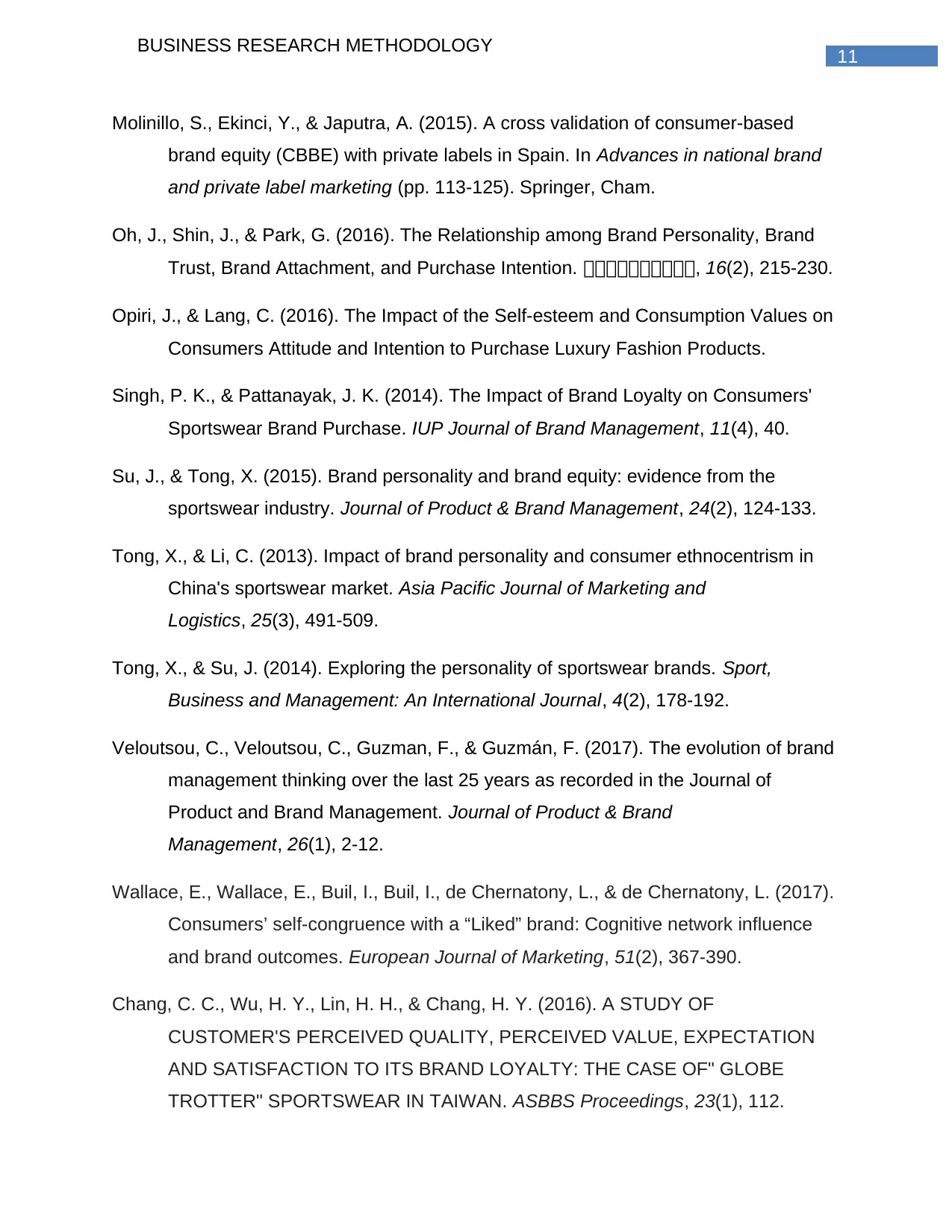
11
BUSINESS RESEARCH METHODOLOGY
Molinillo, S., Ekinci, Y., & Japutra, A. (2015). A cross validation of consumer-based
brand equity (CBBE) with private labels in Spain. In Advances in national brand
and private label marketing (pp. 113-125). Springer, Cham.
Oh, J., Shin, J., & Park, G. (2016). The Relationship among Brand Personality, Brand
Trust, Brand Attachment, and Purchase Intention. 인인인인인인인인인인, 16(2), 215-230.
Opiri, J., & Lang, C. (2016). The Impact of the Self-esteem and Consumption Values on
Consumers Attitude and Intention to Purchase Luxury Fashion Products.
Singh, P. K., & Pattanayak, J. K. (2014). The Impact of Brand Loyalty on Consumers'
Sportswear Brand Purchase. IUP Journal of Brand Management, 11(4), 40.
Su, J., & Tong, X. (2015). Brand personality and brand equity: evidence from the
sportswear industry. Journal of Product & Brand Management, 24(2), 124-133.
Tong, X., & Li, C. (2013). Impact of brand personality and consumer ethnocentrism in
China's sportswear market. Asia Pacific Journal of Marketing and
Logistics, 25(3), 491-509.
Tong, X., & Su, J. (2014). Exploring the personality of sportswear brands. Sport,
Business and Management: An International Journal, 4(2), 178-192.
Veloutsou, C., Veloutsou, C., Guzman, F., & Guzmán, F. (2017). The evolution of brand
management thinking over the last 25 years as recorded in the Journal of
Product and Brand Management. Journal of Product & Brand
Management, 26(1), 2-12.
Wallace, E., Wallace, E., Buil, I., Buil, I., de Chernatony, L., & de Chernatony, L. (2017).
Consumers’ self-congruence with a “Liked” brand: Cognitive network influence
and brand outcomes. European Journal of Marketing, 51(2), 367-390.
Chang, C. C., Wu, H. Y., Lin, H. H., & Chang, H. Y. (2016). A STUDY OF
CUSTOMER'S PERCEIVED QUALITY, PERCEIVED VALUE, EXPECTATION
AND SATISFACTION TO ITS BRAND LOYALTY: THE CASE OF" GLOBE
TROTTER" SPORTSWEAR IN TAIWAN. ASBBS Proceedings, 23(1), 112.
BUSINESS RESEARCH METHODOLOGY
Molinillo, S., Ekinci, Y., & Japutra, A. (2015). A cross validation of consumer-based
brand equity (CBBE) with private labels in Spain. In Advances in national brand
and private label marketing (pp. 113-125). Springer, Cham.
Oh, J., Shin, J., & Park, G. (2016). The Relationship among Brand Personality, Brand
Trust, Brand Attachment, and Purchase Intention. 인인인인인인인인인인, 16(2), 215-230.
Opiri, J., & Lang, C. (2016). The Impact of the Self-esteem and Consumption Values on
Consumers Attitude and Intention to Purchase Luxury Fashion Products.
Singh, P. K., & Pattanayak, J. K. (2014). The Impact of Brand Loyalty on Consumers'
Sportswear Brand Purchase. IUP Journal of Brand Management, 11(4), 40.
Su, J., & Tong, X. (2015). Brand personality and brand equity: evidence from the
sportswear industry. Journal of Product & Brand Management, 24(2), 124-133.
Tong, X., & Li, C. (2013). Impact of brand personality and consumer ethnocentrism in
China's sportswear market. Asia Pacific Journal of Marketing and
Logistics, 25(3), 491-509.
Tong, X., & Su, J. (2014). Exploring the personality of sportswear brands. Sport,
Business and Management: An International Journal, 4(2), 178-192.
Veloutsou, C., Veloutsou, C., Guzman, F., & Guzmán, F. (2017). The evolution of brand
management thinking over the last 25 years as recorded in the Journal of
Product and Brand Management. Journal of Product & Brand
Management, 26(1), 2-12.
Wallace, E., Wallace, E., Buil, I., Buil, I., de Chernatony, L., & de Chernatony, L. (2017).
Consumers’ self-congruence with a “Liked” brand: Cognitive network influence
and brand outcomes. European Journal of Marketing, 51(2), 367-390.
Chang, C. C., Wu, H. Y., Lin, H. H., & Chang, H. Y. (2016). A STUDY OF
CUSTOMER'S PERCEIVED QUALITY, PERCEIVED VALUE, EXPECTATION
AND SATISFACTION TO ITS BRAND LOYALTY: THE CASE OF" GLOBE
TROTTER" SPORTSWEAR IN TAIWAN. ASBBS Proceedings, 23(1), 112.
⊘ This is a preview!⊘
Do you want full access?
Subscribe today to unlock all pages.

Trusted by 1+ million students worldwide
1 out of 13
Related Documents
Your All-in-One AI-Powered Toolkit for Academic Success.
+13062052269
info@desklib.com
Available 24*7 on WhatsApp / Email
![[object Object]](/_next/static/media/star-bottom.7253800d.svg)
Unlock your academic potential
Copyright © 2020–2025 A2Z Services. All Rights Reserved. Developed and managed by ZUCOL.





